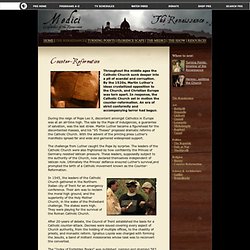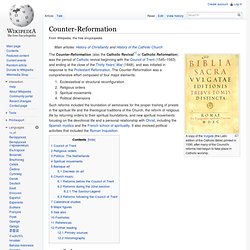

The Reformation and Counter Reformation. The Reformation and Counter Reformation Europe's Search For Stability The Reformation was the religious revolution that took place in the Western church in the 16th century; its greatest leaders were Martin Luther and John Calvin.

Having far-reaching political, economic and social effects, the Reformation became the basis for the founding of Protestantism, one of the three major branches of Christianity. The world of the late medieval Catholic Church from which the 16th-century reformers emerged was a complex one. Over the centuries, the church, particularly in the office of the papacy, had become deeply involved in the political life of Western Europe. The Reformation of the 16th century was not unprecedented.
The Reformation movement within Germany diversified almost immediately, and other reform movements arose independently of Luther. From the group surrounding Zwingli emerged those more radical than himself. "Rome, the Renaissance and Counter Reformation" EtruscansAncient Rome Medieval Rome RenaissanceBaroqueModern Rome The reaction of Pope Paul III (1534 - 1549, Alessandro Farnese) to the Protestant reform was to summon the council of Trent (1545-1563) and the Counter-Reformation.

The most vividly remembered result is the Holy Inquisition which had begun in Spain and which the church extended to other countries. The objective of the Counter-Reformation was to use moral persuasion and the Holy Inquisition to minimise the effects of the (northern) reformers in an attempt to maintain unity of faith and of the Catholic church. Nevertheless the Reformist movement gained the support of many national states of northern Europe which were keen to challenge the political strength and material wealth of the Roman church. The church employed the newly founded Jesuit order as a tool to stem heresy through moral persuasion and teaching as well as a missionary vehicle aimed at Christianisation of the New World. Food for thought….. Medici: Godfathers of the Renaissance . Renaissance . Counter Reformation.
Throughout the middle ages the Catholic Church sunk deeper into a pit of scandal and corruption.

By the 1520s, Martin Luther's ideas crystallized opposition to the Church, and Christian Europe was torn apart. In response, the Catholic Church set in motion the counter-reformation. An era of strict conformity and accompanying terror had begun. During the reign of Pope Leo X, discontent amongst Catholics in Europe was at an all-time high. The sale by the Pope of indulgences, a guarantee of salvation, was the last straw. Counter-Reformation. A copy of the Vulgate (the Latin edition of the Catholic Bible) printed in 1590, after many of the Council's reforms had begun to take place in Catholic worship.

The Counter-Reformation (also the Catholic Revival[1] or Catholic Reformation) was the period of Catholic revival beginning with the Council of Trent (1545–1563) and ending at the close of the Thirty Years' War (1648), and was initiated in response to the Protestant Reformation. The Counter-Reformation was a comprehensive effort composed of four major elements: Ecclesiastical or structural reconfigurationReligious ordersSpiritual movementsPolitical dimensions Council of Trent[edit] A session of the Council of Trent, from an engraving. Pope Paul III (1534–1549) initiated the Council of Trent (1545–1563), a commission of cardinals tasked with institutional reform, addressing contentious issues such as corrupt bishops and priests, indulgences, and other financial abuses.
Religious orders[edit] Politics: The Netherlands[edit] Protestant Reformation. Although the core motivation behind these changes was theological, many other factors played a part, including the rise of nationalism, the Western Schism which eroded people's faith in the Papacy, the corruption of the Curia, and the new learning of the Renaissance which questioned much traditional thought.

On a technological level the invention of the printing press proved extremely significant in that it provided the means for the rapid dissemination of new ideas. Time Line Renaisaance and reformation 1440-1648.